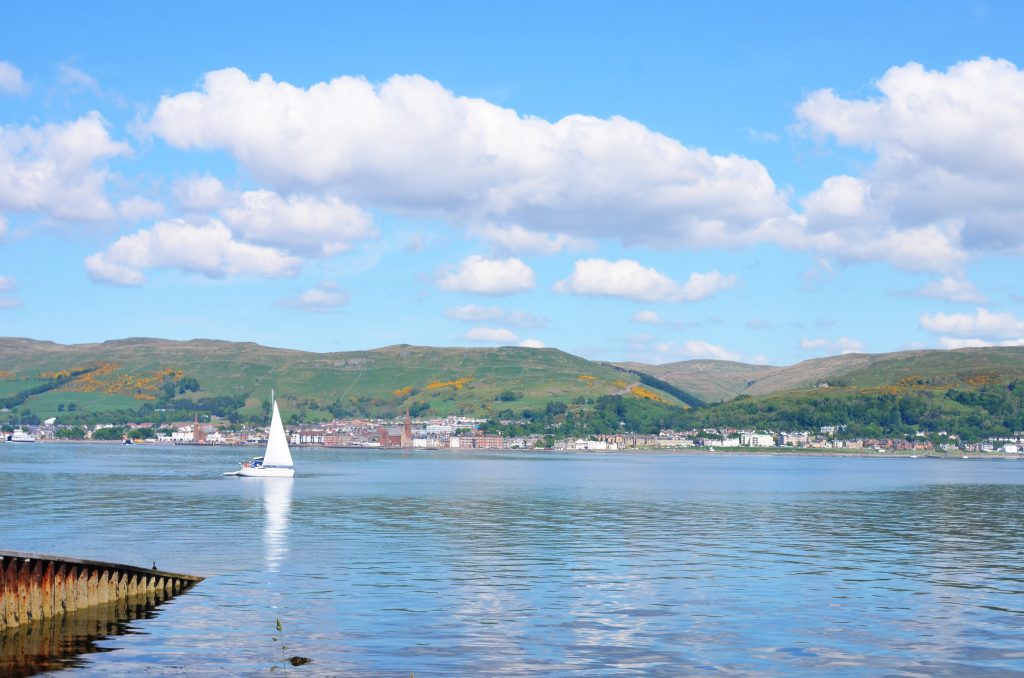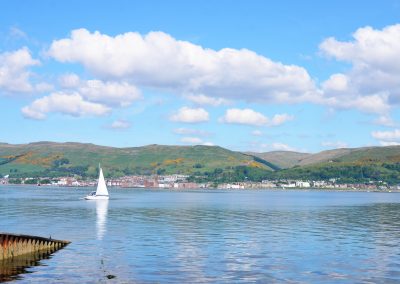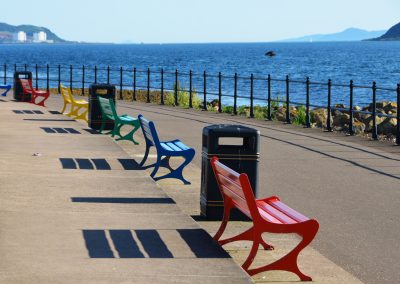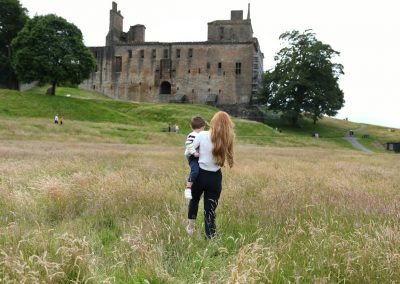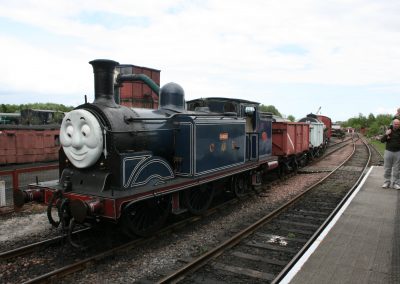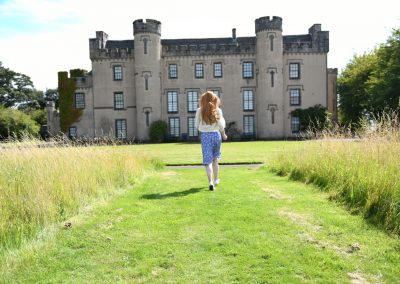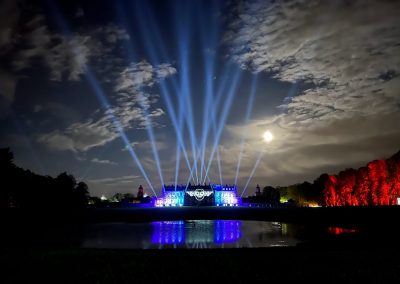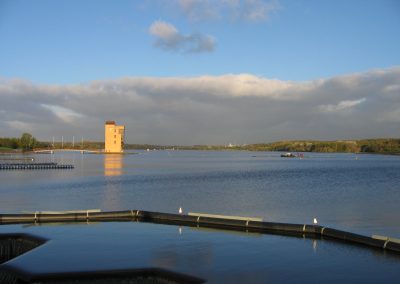Scottish Road Trips
The Central Belt
So many of the road trips in Scotland are focused around the Highlands and Islands but the central belt of Scotland is awash with amazing sights as well. Although it’s often considered (somewhat unfairly) to be one of the less scenic parts of the country, is also one of the most dense. Everything is much more compact, the roads are better (and faster) and the the amenities are less spread out, making it easier to pack in more sights in a much shorter time.
The central belt of Scotland also has the advantage of close proximity to both Edinburgh and Glasgow, so if you’re staying in either city, many of the attractions on this route would make an easy day trip, if you don’t have time for a longer road trip.

1. Cramond Beach
Cramond Beach is a picturesque beach located on the southern shoreline of Edinburgh, Scotland. It is situated between the Firth of Forth and the River Almond and was once an important fishing village. The village on the river front is beautiful and has some cafes, public toilets and a regular ice cream van, which is always popular with younger visitors (and, okay, plenty of the older ones, too!).
Visitors can explore the ruins of an ancient Roman fort and walk across to Cramond Island, which is accessible via a causeway at low tide. You can check out the tide times here, and we’d really recommend doing this before you start the walk, as it’s a long way there and back and many people have been caught on the island and have had to be either rescued by the coastguard or spend an uncomfortable night on the island itself. Don’t say we didn’t warn you!
The sandy beach is one of the most popular in the central belt of Scotland, and offers stunning views across the Firth of Forth, making it a popular spot for visitors in search of a beautiful beach experience. It’s also home to several species of wildlife including puffins and seals. The tide goes out a long way exposing a huge area of sandy that makes for a wonderful picture.
2. South Queensferry
South Queenferry is a small town located on the Firth of Forth. It was once a fishing village, and is now known for its iconic 3 bridges, including the Forth Rail Bridge and the beautiful new Queensferry Crossing. The town has a long maritime history, with Viking settlers making it their home in the 8th century. Visitors can explore historical sites such as St Mary’s Kirk or take a boat tour to see the local birdlife. Other attractions include walks along the shoreline and nearby Dalmeny Country Park, shopping at local stores, and of course enjoying some traditional fish and chips at one of the local eateries! The cobbled streets and floral displays are to some of the best in the central belt of Scotland, so don’t forget your camera.
3. Hopetoun House
Hopetoun House is a stunning stately home located near South Queensferry, it has great views back to the bridges and has fantastic garden walks. Built between 1699 and 1707, it was the residence of some of Scotland’s most prominent aristocratic families throughout the generations. It is an elegant example of Georgian architecture and one of the best-preserved stately homes in Scotland. Today, visitors can explore its world-famous grounds and gardens, which include a charming walled garden and an 18th century Italian terraced garden. There is a fee to walk through the gardens and to visit the house but it is great value in our opinion. You can also walk to Abercorn cemetery from the grounds, it has some incredibly old grave stones and a little free museum with some ancient stones.
4. Midhope House
The central belt of Scotland certainly has its fair share of castles and stately homes, but Midhope House is one of the most instantly recognisable, even in its current ruined state. Midhope is a 16th century tower house located near South Queensferry, and it’s perhaps better known as Lallybroch – the ancestral home of the fictional character Jamie Fraser from the Outlander series. The house itself has undergone several renovations and additions throughout the years, however many of its original features still remain intact including a turreted entrance gate and a great hall with a large oak door.

5. House of the Bins
The House of the Bins is situated in a scenic location that overlooks the Firth of Forth and is surrounded by lush green fields. It was built in 15th century and retains much of its original grandeur, including high ceilings with plasterwork detailing, ornate wooden staircases, intricate paneling and wood carvings, as well as fine examples of period furniture. In addition, visitors can discover a secret tunnel and explore the historic gardens which feature rare trees and plants. Be sure to take the walk to the Tower of the Bins for the outstanding views – you’ll find a plaque there detailing the hilarious story of how it came to be built.
6. Blackness Castle
If you love castles and mysterious tales, then visiting Blackness Castle is a must. This centuries-old Scottish castle has been around since at least the 14th century and is located near the mouth of the Firth of Forth, in the central belt of Scotland. Not only does it have an interesting history filled with stories about Jacobites plotting revolution and English forces occupying the site during conflicts, but it also offers beautiful views from its historic ramparts. From the top, visitors can observe boats passing through the picturesque esplanade, spot wildlife living along one of Scotland’s most famous rivers, and take in some breathtakingly scenic vistas towards Edinburgh’s skyline on clear days. Outlander fans, meanwhile, will recognize the inner courtyard a filming location where Jamie Fraser received a brutal lashing.

7. Boness Kinneil Railway
The Boness Kinneil Railway is a historic railway located in West Lothian, in the central belt of Scotland. The railway was first opened in 1864 and operated both passenger and freight services. Today, the railway is a popular tourist attraction, providing visitors with an opportunity to experience the nostalgia of travel by steam train. The railway runs a variety of special events throughout the year, including steam gala weekends, vintage bus rallies, and murder mystery dinner trains. Visitors can also take a wander through the railway’s museum and engine shed to learn about the history of the railway and see the impressive collection of locomotives and rolling stock.
8. Kinneil Estate
For history buffs and nature lovers alike, Kinneil Estate is a fascinating destination to explore.
Located in the town of Bo’ness, in the central belt of Scotland, this sprawling estate boasts an extensive history dating back to the 12th century. Throughout the centuries, it served as a home to a number of notable families, including the Hamiltons and the Flemings. Today, visitors can walk around Kinneil House, a beautifully preserved mansion that reflects the estate’s rich history. The estate’s grounds are equally impressive, featuring a wide range of wildlife, a walled garden, and even the ruins of an historic church and a Roman fort. Whether you’re interested in architecture, nature, or history, Kinneil Estate is an excellent place to explore.
9. Linlithgow Palace
Have you ever wondered what it would be like to travel back in time? Well, a visit to Linlithgow Palace will make you feel like you’ve done just that. This 15th century palace is one of the central belt of Scotland’s most important historical sites.
Originally built by King James I in 1424, Linlithgow Palace was originally intended as a royal residence for himself and his family. Over the years, the palace had an array of prominent visitors including Mary Queen of Scots (Who was born there) and her son, James VI. During this time period, Linlithgow also served as a major political center with multiple embassies visiting each year. Despite its importance, however, the palace eventually fell into disrepair in the 17th century and was largely abandoned by 1746.
Although some of the palace is now in ruins, it still retains some impressive features from its glory days. One thing that stands out is its grand facade which includes towering spires and intricate stone carvings that are both aesthetically pleasing and historically relevant (they depict stories from Scottish folklore). In addition, there is an impressive fountain court with two large fountains at either end, surrounded by lush gardens. Of course, visitors should also explore the Great Hall for an up close look at how royalty lived hundreds of years ago.
In recent decades, efforts have been made to preserve what remains of this magnificent structure so that future generations can appreciate its beauty and significance in history. In fact, UNESCO has recognized the site as part of The Heart Of Neolithic Orkney World Heritage Site since 2000 due to its cultural value and importance to Scotland’s history. Visitors can explore both inside and outside areas including The Royal Chambers where Mary Queen of Scots spent time during her reign, as well as various other parts such as The Chapel Royal which dates back to 1490 AD.
Linlithgow Palace has stood for centuries despite many changes in Scotland’s history over time – changes that include wars, epidemics and even economic upheaval. Today it remains one of Scotland’s most important historical sites—a place where visitors can step back in time for a glimpse into what life must have been like for kings and queens hundreds of years ago.
10. Muiravonside
Muiravonside first came into being in 1851 when it was built by William Orr Ewing on the site of an old Roman camp known as Ardoch. The house was a Victorian manor house with an impressive façade that featured intricate carvings and detailed stone work. The grounds themselves are filled with lush gardens, woodlands, and ponds that make for a truly tranquil experience.
The estate was owned by several prominent families throughout its history, including the renowned Sinclair family who owned it from 1889-1905. During their time at the estate, they added several extensions to the main house in order to accommodate their growing family and guests. There is now a wonderful farm there, which is free to visit – the only fee is a small one for parking. The walks there are fantastic, and kids will love the farm, playpark and small cafe.
Muiravonside is also home to the incredible Avon Aqueduct which is a marvel of engineering and a sight to behold. Built in the 1820s, this impressive structure spans 810 feet and stands 86 feet high, carrying the Union Canal over the River Avon. Its elegant arches and impressive stonework are a testament to the skill and craftsmanship of the engineers and builders who constructed it. Today, the aqueduct is a popular destination for visitors, who come to marvel at its beauty and explore the surrounding countryside. You can walk right under the bridge feeling it’s sheer size or if you’re brave enough, you can walk along the narrow canal side path crossing the bridge.
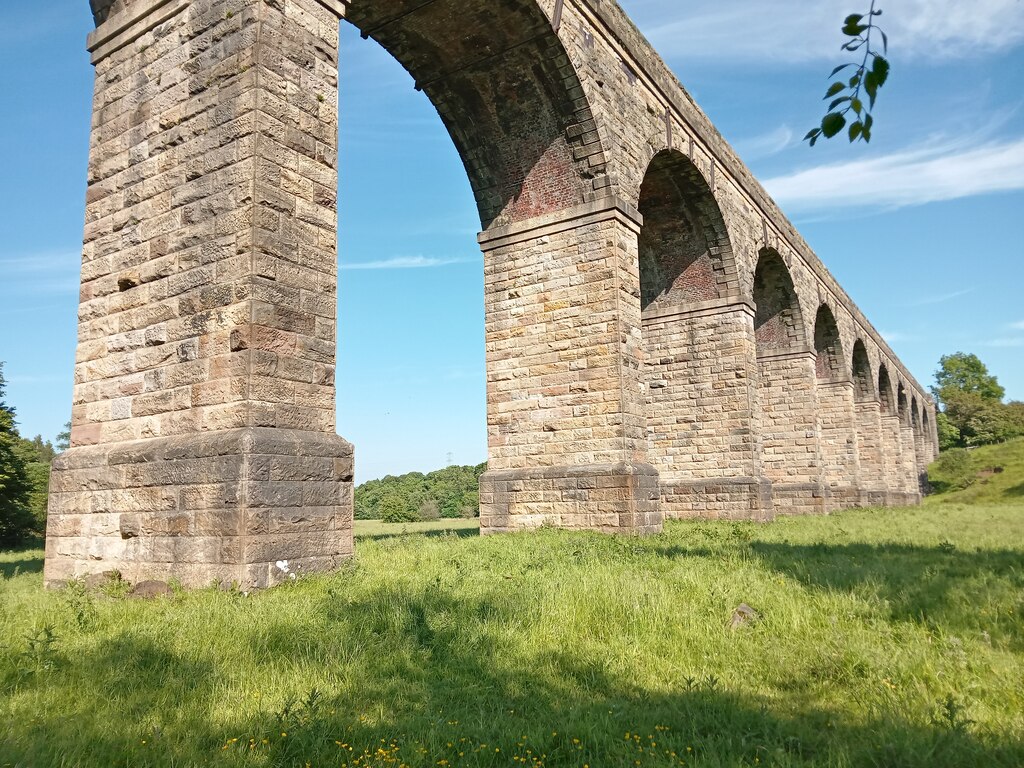
11. Cairnpapple Hill
Perched atop a hill in West Lothian, Cairnpapple Hill offers visitors a journey back in time. Archaeological evidence suggests that this Neolithic site has been used for ceremonial purposes as far back as 3000BC. From the cairn at the summit, visitors can take in panoramic views of the surrounding countryside, including the Firth of Forth and Edinburgh’s skyline in the distance. The site offers a glimpse into a time when ancient peoples gathered at this spot to honor their ancestors and perhaps even the gods. There is a small car park at teh foot of the hill with a 5 minute walk to the top that is not too dofficult although there is rise of around 40m over the whole walk.
12. The Owl Centre Polkement
The Owl Centre at Polkemmet Country Park, near Whitburn, in the central belt of Scotland, is a haven for owl enthusiasts and nature lovers alike. Visitors to this charming center can observe and interact with a variety of owl species, including majestic barn owls, and petite pygmy owls. The center offers tours and educational programs that teach visitors about the behavior and habitat of these fascinating creatures. The owl center is set in the grounds of Polkemmet Country Park, the former site of the Bailey estate, which was one of the most significant country estates in the central belt of Scotland, and it has multiple play areas, public toilets, plenty of parking, a golf course, and a driving range.
13. Strathclyde Country Park
Strathclyde Country Park is an oasis of tranquility amid the hustle and bustle of everyday life. With its vast expanse of greenery, sparkling streams, and peaceful walking trails, the park is the perfect place for a walk, some entertainment and a bit of exercise. There are several play parks around the lake and also some well preserved roman ruins. Whether you’re picnicking on the banks or cycling along the winding paths, there’s something for everyone here. And with its stunning scenery and welcoming, friendly atmosphere, it’s easy to see why Strathclyde Country Park is a popular destination for both locals and tourists alike.
14. National Museum of Rural Life
Located in East Kilbride, Scotland, the National Museum of Rural Life offers visitors a fascinating glimpse into the country’s rural past. Set on a working farm, this unique museum showcases the evolution of Scottish farming and rural life over the centuries. Visitors can explore the various exhibits including traditional tools and machinery, as well as historic homes and cottages furnished in the style of different eras. One of the highlights of the museum is the chance to meet and interact with the farm animals, including Highland cattle and Tamworth pigs. With its immersive displays and interactive experiences, the National Museum of Rural Life is a must-see attraction for those interested in the history and culture of Scotland’s rural communities.
15. Calderglen Country Park and Zoo
Calderglen Country Park and Zoo is nothing short of enchanting. Spread over 170 acres of picturesque land, this area is a major attraction for animal lovers and nature enthusiasts alike. From wallabies to otters, meerkats to owls, and even Highland cows, there is an array of creatures to marvel at. On top of that, the park is home to beautiful walking trails, scenic waterfalls, and a charming children’s play area.
16. Largs
The charming town of Largs is on the western coast of Scotland. With its stunning views of the Firth of Clyde and the islands that spread out into the distance, it’s no wonder that Largs is a popular tourist destination. History buffs will appreciate the town’s rich history, with landmarks such as the 13th-century castle and the Vikingar! museum, while outdoor enthusiasts will love exploring the scenic hiking trails and beaches. The town is also home to a thriving local arts scene, with galleries showcasing the work of talented Scottish artists. And when it comes to dining, visitors won’t be disappointed – the seafood caught in the surrounding waters is especially delicious.
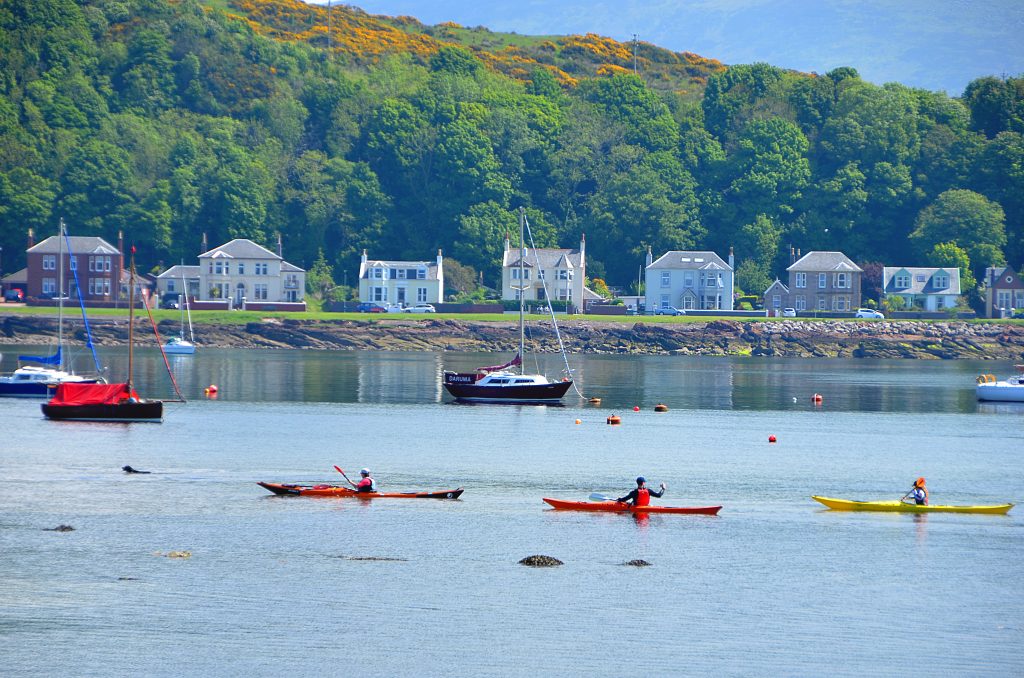
17. Millport
Millport is on the small island of Great Cumbrae which is situated off the west coast of Scotland. Known for its stunning scenery and relaxed atmosphere, Millport is a popular destination for tourists looking to escape the hustle and bustle of city life.
The town is home to a range of amenities, including shops, cafes, and restaurants, which cater to the needs of visitors from all over the world. Millport also boasts a rich history, from the Garrison House Museum to the 1733 Cathedral of the Isles. The island itself is just four miles long and two miles wide, making it the perfect place to explore on foot or by bike. With its quaint streets, sandy beaches, and panoramic views, it’s easy to see why Millport is considered one of Scotland’s most beautiful islands.
